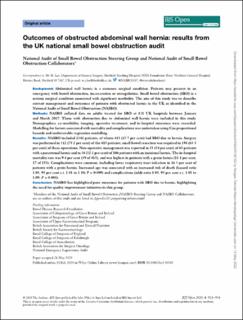| dc.description.abstract | Background
Abdominal wall hernia is a common surgical condition. Patients may present in an emergency with bowel obstruction, incarceration or strangulation. Small bowel obstruction (SBO) is a serious surgical condition associated with significant morbidity. The aim of this study was to describe current management and outcomes of patients with obstructed hernia in the UK as identified in the National Audit of Small Bowel Obstruction (NASBO).
Methods
NASBO collated data on adults treated for SBO at 131 UK hospitals between January and March 2017. Those with obstruction due to abdominal wall hernia were included in this study. Demographics, co-morbidity, imaging, operative treatment, and in-hospital outcomes were recorded. Modelling for factors associated with mortality and complications was undertaken using Cox proportional hazards and multivariable regression modelling.
Results
NASBO included 2341 patients, of whom 415 (17·7 per cent) had SBO due to hernia. Surgery was performed in 312 (75·2 per cent) of the 415 patients; small bowel resection was required in 198 (63·5 per cent) of these operations. Non-operative management was reported in 35 (54 per cent) of 65 patients with a parastomal hernia and in 34 (32·1 per cent) of 106 patients with an incisional hernia. The in-hospital mortality rate was 9·4 per cent (39 of 415), and was highest in patients with a groin hernia (11·1 per cent, 17 of 153). Complications were common, including lower respiratory tract infection in 16·3 per cent of patients with a groin hernia. Increased age was associated with an increased risk of death (hazard ratio 1·05, 95 per cent c.i. 1·01 to 1·10; P = 0·009) and complications (odds ratio 1·05, 95 per cent c.i. 1·02 to 1·09; P = 0·001).
Conclusion
NASBO has highlighted poor outcomes for patients with SBO due to hernia, highlighting the need for quality improvement initiatives in this group. | en_US |

